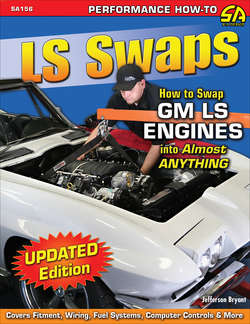Читать книгу LS Swaps - Jefferson Bryant - Страница 6
На сайте Литреса книга снята с продажи.
ОглавлениеIntroduction
The goal of most engine swaps is to increase performance, and in almost all cases the LS engines meet that goal. The Gen III/IV engine platform represents the largest-growing segment of the performance automotive aftermarket, so there are many options for increasing the performance of an LS-series engine. There are simple bolt-on components such as larger throttle bodies or high-flow intakes, and there are serious performance upgrades such as high-lift camshafts and large-port cylinder heads.
Although the factory fits its high-performance LS engines with superchargers, the most popular big-boost upgrade is adding a turbocharger. Driven off the exhaust rather than the drive belts, a turbo provides “free” horsepower. A single turbo fitted to the 5.3 Vortec engine can make more than 500 hp with no additional mods, other than a properly calibrated ignition map.
With all of these options, Gen III/IV engine swaps have become more and more popular. This book gives you the knowledge of where to find the engine that best suits your needs and covers all the details of performing the swap. Although every car and swap is different, there are quite a few common aspects.
An LS swapping project is fairly easy if it is carefully conceived, researched, and planned. The Gen III/IV engine families have a similar footprint with the original small-block Chevy. If a traditional small-block Chevy can be swapped into a particular vehicle, you can certainly install an LS engine as well, but some minor adjustments, such as re-arranging the drive pulleys and other components may be required. The possibilities are endless.
Many creative builders have swapped LS engines into everything from Volvos to BMWs to Honda Civics, and even a Honda S2000, which is sure to be a scary ride. Although most builders are familiar with carburetors and how they work, fuel-injection systems, computers, and wiring harness hookups intimidate many swappers. The electronics are an integral component of a swap and a particular car or other vehicle can be adapted to run the engine’s vital electronic systems. In most cases, the wiring harness, connectors, and wiring must be carefully modified, or the correct aftermarket components for plugging in a particular engine to a specific car can be purchased. Shops such as Street & Performance and Painless Performance provide the products and support to help simplify the wiring harness. Tuning companies such as HP Tuners and EFI Live can reprogram the electronic control module (ECM) to adapt it for a swap. In the end, you get a more efficient power plant for your vehicle, with the ability to tune it better and faster.
For simplicity’s sake, many electronic controls can be eliminated by installing a carburetor on an LS engine, as is the case with the LS364. In addition, an aftermarket carbureted intake designed for the LS-series engines can be used. These engines are just as powerful and still take advantage of the electronic spark distribution, using the one-coil-per-cylinder design. A spark controller is still necessary, as these engines do not have a provision for a traditional distributor, but these control boxes are very easy to wire.
One of the biggest benefits of the new Gen III/IV engines is efficiency. These engines were designed to meet the strict Corporate Average Fuel Economy (CAFE) standards for new vehicles. This means that the Gen III/IV engines must meet the fuel-economy ratings, all while making significant horsepower numbers. In the past, making 400 hp and getting 20 mpg with a small-block Chevy was an impossible proposition. With an LS engine, it is not only achievable, it’s standard. The 2013 ZR1 Corvette cranks out 638 hp from the LS9 and maintains 21 mpg highway, 14 mpg city. A Gen I small-block Chevy cannot even get close to those numbers. A stock Vortec 5.3 liter with an overdrive automatic can produce 350 hp and attain 20 mpg with a custom ECM tune.
All of these factors together add up to make the Gen III/IV engines the most popular swap since the original small-block Chevy hit the dealers in 1955. With so many variations, there is sure to be a Gen III/IV engine to suit your application.
